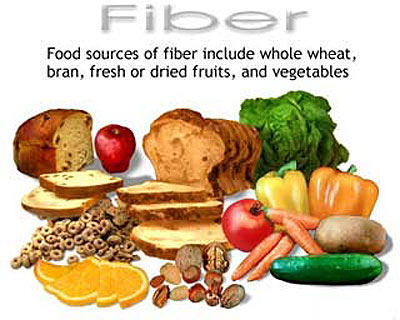There are two general types of fiber – soluble and insoluble – each with its own health benefits. Soluble fiber forms a gel – like substance that delays absorption of glucose (Sugar) in the intestines and helps prevent cholesterol absorption. Soluble types include gums (such as guar), pectin’s, mucilage’s, beta-glucan, and oligosaccharides (such as inulin, now added to some yogurts). Insoluble fiber – parts of cell walls, like cellulose – increases stools bulk and speeds transit of food through the gut. Plant foods contain a mix of both soluble and insoluble fiber. The best sources of soluble fiber are oats, barley, legumes (beans, peas, and lentils), psylium, seeds, and some fruits (such as apples, blueberries, and citrus) and vegetables (such as lady finger). The best sources of insoluble fiber are cereals (especially those containing wheat bran), nuts, and some fruits and vegetables, like cauliflower and green beans.
Though our bodies don’t have the enzymes to digest fiber, some is broken down (fermented) by bacteria in our intestines. Thus, another way of classifying fiber, which some experts now prefer, is by how fermentable it is. Highly fermentable fiber includes gums like those present in fenugreek seeds and most other soluble fibers.
Fiber Benefits – Heart (Cardiovascular) disease
Fiber helps reduce certain risk factors for heart disease. In a large French study in the American Journal of Clinical Nutrition, people who consumed at least 25 grams of fiber a day from food were less likely to have hypertension and high cholesterol and to be overweight. In addition, higher fiber intake was associated with lower triglycerides (fats in the blood). Two recent reviews that together looked at nearly 50 studies also confirmed fiber’s ability to reduce elevated blood pressure. Scientists are beginning to study fiber’s potential for reducing inflammation in the body, another way it may lower the risk of heart disease. Fiber Benefits – Diabetes
Studies have linked low fiber diets to an increased risk of type 2 diabetes, and high-fiber diets to a reduced risk of insulin resistance (sometimes called pre-diabetes). There’s evidence that both soluble and insoluble fiber can help. Soluble fiber, in particular, improves blood sugar control by slowing the absorption of glucose. People with diabetes who get enough fiber diet may be able to reduce their need for insulin or other drugs. Fiber Benefits – Weight control
Fiber may help promote weight loss, though not all studies have found this. People with higher fiber diet intake tend to have lower body weight. High-fiber foods are often lower in calories than other foods, and they help you feel full, so you eat less. fiber diet may also reduce insulin secretion and alter hormones in the digestive tract that influence body weight.
Fiber Benefits – Digestive problems
Because fiber increases stool bulk and frequency of bowel movements, it is often recommended as a way to prevent and treat constipation – especially if you get very little fiber to begin with. fiber, also seems to help diverticular disease (a painful condition in which tiny pouches in the intestinal walls trap food and may become inflamed) by preventing constipation and strained bowel movements, thereby reducing pressure in the colon. Whether fiber helps in irritable bowel syndrome or other intestinal conditions is
Although at least two large Harvard studies failed to prove any benefit of fiber in preventing colon cancer, experts still refuse to write it off completely. The idea that fiber could protect against colon cancer arose in the late 1960s when the British researcher Dr. Denis Burkett observed that Africans who ate a traditional high-fiber diet rarely developed colon cancer. Experts think fiber may protect by speeding the transit time of waste through the gut, thereby reducing contact of carcinogens with the lining of the intestines. Or it may dilute carcinogens or inactivate them in some way.uncertain – some people improve with certain types of fibers, while others feel worse. Fiber Benefits – Colon cancer
For more details about fiber foods see fiber quantities and supplements.

